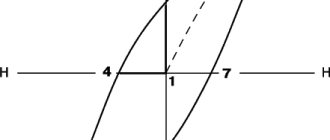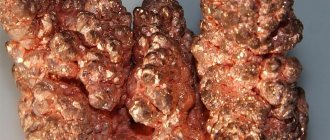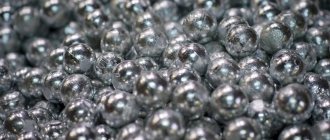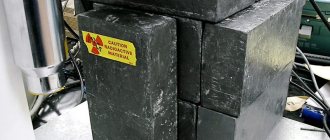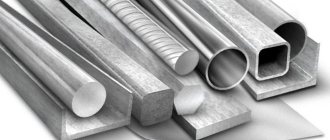Magnetic properties of the substance:
Numerous experiments show that a magnetic field interacts with all substances without exception, changing their physical and chemical properties. Manifestations of this interaction can be different.
Let's take a powerful electromagnet with conical pole pieces, place a bismuth ball between the poles, balanced on small scales (Fig. 2.18). When the power supply circuit of the electromagnet is closed, the balance will be disrupted: the ball will come out of the magnetic field.
Let's place the burning candle so that its flame is between the poles of the magnet. Having closed the magnet power circuit, we will see that the flame is pushed out of the magnetic field (Fig. 2.19).
The phenomena described above were observed back in the 19th century. M. Faraday, who called them diamagnetic, and the substances with which such phenomena occurred - diamagnetic.
Careful studies of diamagnetic phenomena have shown that the magnetic induction in a diamagnetic material is less than the magnetic induction of an external field: . This effect is explained by the changes that occur in the atoms of a diamagnetic material when a substance is introduced into a magnetic field, therefore this effect is observed in all substances.
Substances that exhibit a diamagnetic effect are called diamagnetic.
The effect of a substance on a magnetic field is described by a physical quantity called magnetic permeability. It is defined as the ratio of magnetic induction in substance B to magnetic induction outside substance B0:
Magnetic permeability is a dimensionless quantity. For a diamagnetic material it is slightly less than unity.
If an aluminum ball is balanced on a balance above the pole pieces, then when the power circuit is closed it will be drawn into the space between the tips, where the field induction is greater (Fig. 2.20).
Pic 2.20. An aluminum ball is drawn into a magnetic field
Such phenomena are called paramagnetic, and the substances themselves are called paramagnetic. For paramagnets Bu > B0.
The interactions of matter and a magnetic field manifest themselves as diamagnetism, paramagnetism and ferromagnetism.
Paramagnetism manifests itself in substances whose atoms, having their own field, like magnetic arrows, rotate under the influence of an external magnetic field, increasing its magnetic induction.
Most substances belong to diamagnetic or paramagnetic substances, being weakly magnetic substances. Analyzing the values of their magnetic permeability, one can notice that it differs little from unity for both paramagnetic and diamagnetic materials. Therefore, diamagnetism and paramagnetism in most cases do not significantly affect the magnetic properties of the medium.
However, there are substances that interact quite noticeably with a magnetic field. They are called ferromagnets.
A typical sign of a ferromagnet is an abnormally high value of magnetic permeability. Thus, pure iron after long-term annealing in a hydrogen atmosphere has a magnetic permeability of up to 340,000. This means that this ferromagnet enhances the magnetic field by 340,000 times.
The high magnetic permeability of ferromagnets is explained by the peculiarities of their crystal structure. Having some peculiarities in the arrangement of electron orbits, the atoms of a ferromagnet unite so that the entire substance is divided into separate sections - domains.
Domains are areas of a ferromagnet in which the atoms are arranged in an orderly manner. This domain region resembles a small magnet. It has its own field as a result of the addition of the magnetic fields of all the atoms that enter the domain; it interacts with the external magnetic field.
The magnetic fields of all domains in a non-magnetized ferromagnet compensate each other. If a ferromagnet is introduced into the magnetic field of an external source, then a restructuring of the domains will occur. In this case, not only do the boundaries of the domains shift, but the direction of the magnetic induction of each domain separately changes abruptly. Some domains are increasing, others are decreasing. Domains whose magnetic induction of fields forms an obtuse angle with the magnetic induction of the external field decrease, and those for which this angle is acute or equal to zero increase. At a certain value of the magnetic induction of the external magnetic field, saturation appears in the ferromagnet: all domains merge into one large domain, the magnetic induction of which coincides with the direction of the magnetic induction of the external field. Thus, a large increase in the magnetic field occurs.
Structure of matter and magnetism
The first theory explaining the nature of magnetism through the relationship of electrical and magnetic phenomena was created by the French physicist J.-M. Ampere in the 20s of the 19th century. Within the framework of this theory, Ampere assumed the presence in physical bodies of microscopic closed currents, usually compensating each other. But in substances that have magnetic properties, such “molecular currents” create a surface current, causing the material to become a permanent magnet. This hypothesis has not been confirmed, with the exception of one very important idea - about microcurrents as sources of magnetic fields.
Microcurrents in matter actually exist due to the movement of electrons in atoms and create a magnetic moment. In addition, electrons have their own magnetic moment of a quantum nature.
The total magnetic moment of a substance, that is, the totality of elementary currents in it, in relation to a unit volume, determines the state of magnetization of a macroscopic body. In most substances, the particle moments are oriented disorderly (the leading role in this is played by thermal chaotic vibrations), and the magnetization is practically zero.
Ancient China
In ancient China, the earliest literary reference to the electrical and magnetic properties of materials is in a 4th century BC book named after its author, The Sage of the Valley of Ghosts. The earliest mention of the attraction of a needle is in the 1st century work Lunheng (Balanced Queries): “The magnet attracts the needle.”
The 11th-century Chinese scientist Shen Kuo was the first person to describe—in the Dream Pool Essay—the magnetic needle compass and how it improved the accuracy of navigation through astronomical methods. True north concept. By the 12th century, the Chinese were known to use a magnetic compass for navigation. They fashioned a guide spoon out of stone so that the handle of the spoon always pointed south.
Behavior of matter in a magnetic field
Under the action of an external magnetic field, the vectors of the magnetic moments of the particles change direction - the body is magnetized, and its own magnetic field appears in it. The nature of this change and its intensity, which determine the magnetic properties of substances, are determined by various factors:
- features of the structure of electronic shells in atoms and molecules of matter;
- interatomic and intermolecular interactions;
- features of the structure of crystal lattices (anisotropy);
- temperature of the substance;
- magnetic field strength and configuration, and so on.
The magnetization of a substance is proportional to the strength of the magnetic field in it. Their ratio is determined by a special coefficient - magnetic susceptibility. In a vacuum it is zero, in some substances it is negative.
The quantity characterizing the ratio of magnetic induction and field strength in a substance is usually called magnetic permeability. In a vacuum, induction and tension coincide, and its permeability is equal to unity. The magnetic permeability of a substance can be expressed as a relative value. This is the ratio of its absolute values for a given substance and for vacuum (the latter value is accepted as the magnetic constant).
Electromagnets
An electromagnet is a magnet in which a magnetic field is created by an electric current. The magnetic field disappears when the current is turned off. Electromagnets typically consist of many closely spaced turns of wire that create a magnetic field. Wire turns are often wound around a magnetic core made of ferromagnetic or ferrimagnetic material such as iron; The magnetic core concentrates the magnetic flux and creates a more powerful magnet.
The main advantage of an electromagnet over a permanent magnet is that the magnetic field can be quickly changed by controlling the amount of electric current in the winding. However, unlike a permanent magnet, which requires no power, an electromagnet requires a continuous supply of current to maintain the magnetic field.
Electromagnets are widely used as components in other electrical devices such as motors, generators, relays, solenoids, loudspeakers, hard drives, MRI machines, scientific instruments, and magnetic separation equipment. Electromagnets are also used in industry to pick up and move heavy iron objects such as scrap metal and steel. Electromagnetism was discovered in 1820. At the same time, the first classification of materials according to magnetic properties was published.
Source
Classification of substances by magnetic properties
According to the type of behavior of various solid materials, liquids, gases in a magnetic field, several groups are distinguished:
- diamagnetic materials;
- paramagnetic materials;
- ferromagnets;
- ferrimagnets;
- antiferromagnets.
The main magnetic characteristics of a substance that underlie the classification are magnetic susceptibility and magnetic permeability. Let us characterize the main properties inherent in each group.
Renaissance
In 1600, William Gilbert published his Magnetic Corpus and Magnetic Tellurium (On the Magnet and Magnetic Bodies, and the Great Magnet of the Earth). In this work he describes many of his experiments with his model earth, called a terrella, with which he conducted research into the properties of magnetic materials.
From his experiments, he came to the conclusion that the Earth itself was magnetic and that this was why compasses pointed north (previously, some believed that it was the North Star (Polaris) or the large magnetic island at the North Pole that attracted the compass).
Diamagnets
Due to some structural features of electron clouds, atoms (or molecules) of diamagnetic materials do not have a magnetic moment. It appears when an external field appears. The induced, induced field has the opposite direction, and the resulting field turns out to be somewhat weaker than the external one. True, this difference cannot be significant.
The magnetic susceptibility of diamagnetic materials is expressed by negative numbers with an order of magnitude from 10-4 to 10-6 and does not depend on the field strength; magnetic permeability is lower than that of vacuum by the same order of magnitude.
The application of a non-uniform magnetic field leads to the fact that the diamagnetic material is pushed out by this field, as it tends to shift to a region where the field is weaker. The effect of diamagnetic levitation is based on this feature of the magnetic properties of substances of this group.
Diamagnets represent a wide group of substances. It includes metals such as copper, zinc, gold, silver, and bismuth. It also includes silicon, germanium, phosphorus, nitrogen, hydrogen, and inert gases. Complex substances include water, many salts, and organic compounds. Ideal diamagnetic materials are superconductors. Their magnetic permeability is zero. The field cannot penetrate into the superconductor.
20th century and our time
James Clerk Maxwell synthesized and expanded this understanding of Maxwell's equations, combining electricity, magnetism, and optics into the field of electromagnetism. In 1905, Einstein used these laws to motivate his theory of special relativity, requiring that the laws hold true in all inertial frames of reference.
Electromagnetism continued to develop in the 21st century, being incorporated into more fundamental theories of gauge theory, quantum electrodynamics, electroweak theory, and finally the standard model. Nowadays, scientists are already studying the magnetic properties of nanostructured materials with all their might. But the greatest and most amazing discoveries in this field are probably still ahead of us.
Paramagnets
Substances belonging to this group are characterized by positive magnetic susceptibility (very low, about 10-5 – 10-6). They are magnetized parallel to the vector of the applied field, that is, they are drawn into it, but the interaction of paramagnetic materials with it is very weak, like that of diamagnetic materials. Their magnetic permeability is close to the permeability of vacuum, only slightly exceeding it.
In the absence of an external field, paramagnets, as a rule, do not have magnetization: their atoms have their own magnetic moments, but they are oriented randomly due to thermal vibrations. At low temperatures, paramagnetic materials can have a small intrinsic magnetization, which strongly depends on external influences. However, the influence of thermal motion is too great, as a result of which the elementary magnetic moments of paramagnets are never set exactly in the direction of the field. This is the reason for their low magnetic susceptibility.
The forces of interatomic and intermolecular interaction also play a significant role, promoting or, on the contrary, resisting the ordering of elementary magnetic moments. This causes a wide variety of magnetic properties of paramagnetic substances.
This group of substances includes many metals, such as tungsten, aluminum, manganese, sodium, and magnesium. Oxygen, iron salts, and some oxides are paramagnetic.
Types of permeability and formulas
Susceptibility to magnetism depends on the type of medium and is determined by its properties. Therefore, it is customary to talk about the permeability of a particular system, keeping in mind the composition, condition, temperature and other initial data.
There are four types of permeability:
- Relative. Characterizes how much the interaction in the selected medium differs from vacuum.
- Absolute. It is found as the product of permeability and magnetic constant.
- Static. Determined taking into account coercive force and magnetic induction. In this case, the greater the value of the characteristic, the lower the frequency of magnetic losses. It follows that static permeability depends on temperature.
- Differential. Establishes a connection between a small increase in induction and tension - μd = m * tgb. This statement means that the value is determined from the main magnetization curve, due to the nonlinearity of which it is variable.
If the medium is homogeneous and isotropic, then the permeability is determined by the formula: μ = B/(μoH), where: B - magnetic induction; H—tension; μo is a constant. The constant coefficient in the formula is used to write the magnetism equation in a rational form for calculations. His sign is always permanent. It allows you to relate relative magnetic permeability and absolute permeability.
Magnetic susceptibility is related to permeability by the simple expression μ = 1 + χ. This formula is valid if all parameters are measured in SI. In CGS units the equality will take the form μ = 1 + 4πx. For example, the permeability of a vacuum is equal to unity, since x = 0. It is dimensionless and helps to evaluate the magnetization ability of a material in a magnetic field.
There are three types of susceptibility: volumetric, specific and molar. For diamagnetic materials it is negative, and for paramagnetic materials it is positive. Moreover, for ferromagnets its values can reach thousands of units, while for other classes of substances the value is of a very small order, about 10 -4 - 10 -6.
If a material is simultaneously exposed to a constant and alternating magnetic field, then an additional concept is introduced to describe the process - differential permeability. The largest value of the differential parameter will always exceed the static component μ = (1/μо)*(dB/dH). This formula is similar in appearance to the expression describing friction.
Ferromagnets
There is a small group of substances that, due to their structural features, have very high magnetic properties. The first metal in which these qualities were discovered was iron, and thanks to it this group received the name ferromagnets.
The structure of ferromagnets is characterized by the presence of special structures - domains. These are areas where magnetization forms spontaneously. Due to the peculiarities of interatomic and intermolecular interactions in ferromagnets, the most energetically favorable arrangement of atomic and electronic magnetic moments is established. They acquire a parallel orientation along the so-called directions of easy magnetization. However, the entire volume of, for example, an iron crystal cannot acquire unidirectional spontaneous magnetization - this would increase the total energy of the system. Therefore, the system is divided into sections, the spontaneous magnetization of which in the ferromagnetic body compensates for each other. This is how domains are formed.
The magnetic susceptibility of ferromagnets is extremely high, can range from several tens to hundreds of thousands and largely depends on the strength of the external field. The reason for this is that the orientation of domains along the field direction also turns out to be energetically favorable. The direction of the magnetization vector of some domains will necessarily coincide with the field strength vector, and their energy will be the least. Such areas grow, and at the same time, unfavorably oriented domains shrink. Magnetization increases and magnetic induction increases. The process occurs unevenly, and the graph of the relationship between induction and external field strength is called the magnetization curve of a ferromagnetic substance.
When the temperature rises to a certain threshold value, called the Curie point, the domain structure is disrupted due to increased thermal motion. Under these conditions, the ferromagnet exhibits paramagnetic properties.
In addition to iron and steel, ferromagnetic properties are inherent in cobalt and nickel, some alloys and rare earth metals.
Ferrimagnets and antiferromagnets
The two types of magnets also have a domain structure, but the magnetic moments in them are oriented antiparallel. These are groups such as:
- Antiferromagnets. The magnetic moments of the domains in these substances are equal in numerical value and mutually compensated. For this reason, the magnetic properties of antiferromagnetic materials are characterized by extremely low magnetic susceptibility. In an external field they manifest themselves as very weak paramagnets. Above a threshold temperature called the Néel point, such a substance becomes an ordinary paramagnet. Antiferromagnets are chromium, manganese, some rare earth metals, and actinides. Some antiferromagnetic alloys have two Néel points. When the temperature is below the lower threshold, the material becomes ferromagnetic.
- Ferrimagnets. In substances of this class, the magnitudes of the magnetic moments of different structural units are not equal, due to which their mutual compensation does not occur. Their magnetic susceptibility depends on the temperature and strength of the magnetizing field. Ferrimagnets include ferrites, which contain iron oxide.
Story
The material's magnetic properties were first discovered in the ancient world when people noticed that magnets, naturally magnetized pieces of minerals, could attract iron. The word "magnet" comes from the Greek term μαγνῆτις λίθος magnētis lithos, "magnesium stone, footstone."
You may be interested in: Ulyanovsk State Agricultural Academy named after Stolypin
In ancient Greece, Aristotle credited the first of what can be called scientific discussions about the magnetic properties of materials to the philosopher Thales of Miletus, who lived from 625 BC. e. to 545 BC e. The ancient Indian medical text Sushruta Samhita describes the use of magnetite to remove arrows embedded in the human body.
The concept of hysteresis. Permanent magnetism
Ferromagnetic and ferrimagnetic materials have the property of residual magnetization. This property is due to the phenomenon of hysteresis - delay. Its essence is that the change in the magnetization of the material lags behind the change in the external field. If, upon reaching saturation, the field strength is reduced, the magnetization will change not in accordance with the magnetization curve, but in a more gentle manner, since a significant part of the domains remains oriented according to the field vector. Thanks to this phenomenon, permanent magnets exist.
Demagnetization occurs when the direction of the field changes, when it reaches a certain value called the coercive (retention) force. The greater its value, the better the substance retains residual magnetization. The hysteresis loop closes with the next change in voltage in direction and magnitude.
Magnetic hardness and softness
The phenomenon of hysteresis greatly affects the magnetic properties of materials. Substances in which the loop on the hysteresis graph is widened, requiring a significant coercive force for demagnetization, are called hard magnetic; materials with a narrow loop, which are much easier to demagnetize, are called soft magnetic.
In alternating fields, magnetic hysteresis manifests itself especially clearly. It is always accompanied by the release of heat. In addition, in an alternating magnetic field, eddy induction currents arise in the magnet, which generate especially a lot of heat.
Many ferromagnets and ferrimagnets are used in equipment operating on alternating current (for example, electromagnet cores) and are constantly remagnetized during operation. In order to reduce energy losses due to hysteresis and dynamic losses due to eddy currents, soft magnetic materials such as pure iron, ferrites, electrical steels, and alloys (for example, permalloy) are used in such equipment. There are other ways to minimize energy loss.
Hard magnetic substances, on the contrary, are used in equipment operating in a constant magnetic field. They retain residual magnetization much longer, but are more difficult to magnetize to saturation. Many of them are now composites of various types, such as cermet or neodymium magnets.
New time
Understanding of the relationship between electricity and materials with special magnetic properties began in 1819 with the work of Hans Christian Ørsted, a professor at the University of Copenhagen, who discovered by accidentally twitching a compass needle near a wire that an electric current could create a magnetic field. This landmark experiment is known as the Oersted Experiment. Several other experiments followed with André-Marie Amperat, who in 1820 discovered that a magnetic field circulating along a closed path was coupled to a current flowing around the perimeter of the path.
You may be interested in: Regular hexagonal pyramid. Formulas for volume and surface area. Solution of a geometric problem
Carl Friedrich Gauss studied magnetism. Jean-Baptiste Biot and Felix Savart came up with the Biot-Savart law in 1820, which gives the desired equation. Michael Faraday, who in 1831 discovered that time-varying magnetic flux through a loop of wire caused a voltage. And other scientists found further connections between magnetism and electricity.
A little more about the use of magnetic materials
Modern high-tech production requires the use of magnets made from structural materials, including composite materials, with specified magnetic properties of substances. These are, for example, ferromagnetic-superconductor or ferromagnetic-paramagnetic magnetic nanocomposites used in spintronics, or magnetopolymers - gels, elastomers, latexes, ferrofluids, which are widely used.
Various magnetic alloys are also extremely in demand. The neodymium-iron-boron alloy is characterized by high resistance to demagnetization and power: the neodymium magnets mentioned above, being the most powerful permanent magnets to date, are used in a wide variety of industries, despite the presence of some disadvantages, such as fragility. They are used in magnetic resonance imaging scanners, wind generators, when cleaning technical fluids and lifting heavy loads.
Very interesting are the prospects for using antiferromagnets in low-temperature nanostructures for the manufacture of memory cells, which can significantly increase the recording density without disturbing the state of neighboring bits.
It must be assumed that the use of the magnetic properties of substances with given characteristics will increasingly expand and provide serious technological breakthroughs in various fields.
Middle Ages
Alexander Neckam, by 1187, was the first in Europe to describe the compass and its use for navigation. This researcher was the first in Europe to thoroughly establish what properties magnetic materials have. In 1269, Peter Peregrine de Maricourt wrote the Epistola de magnete, the first surviving treatise describing the properties of magnets. In 1282, the properties of compasses and materials with special magnetic properties were described by al-Ashraf, a Yemeni physicist, astronomer and geographer.
